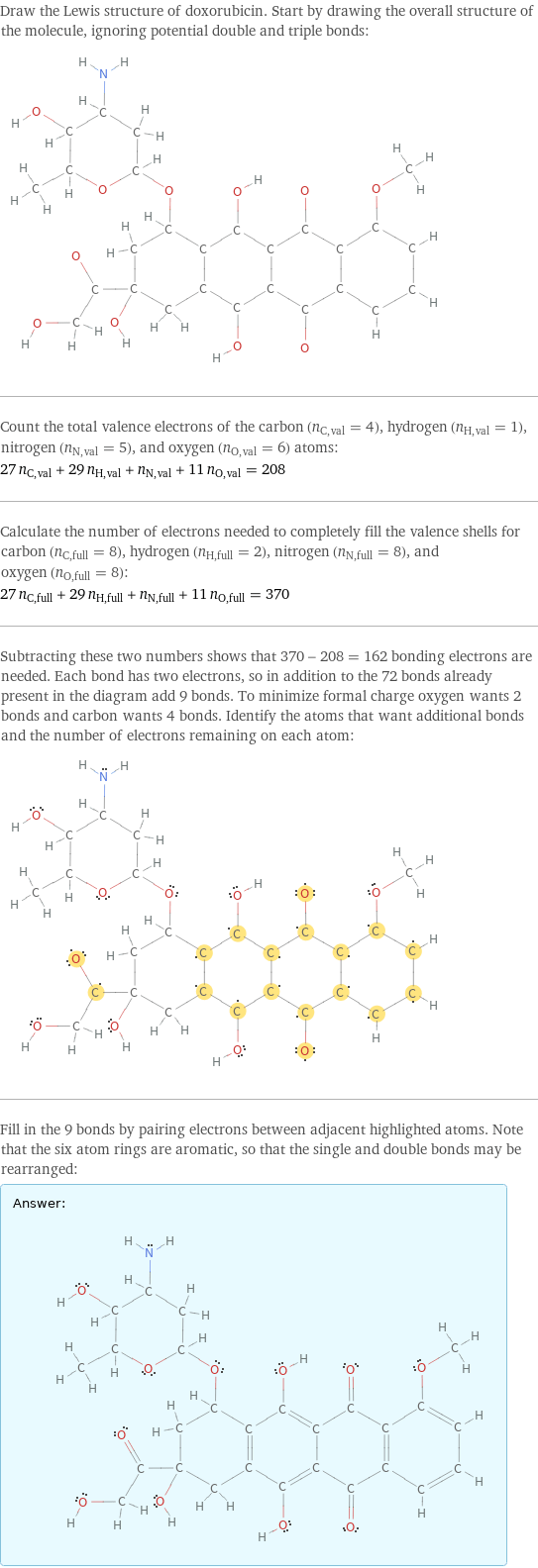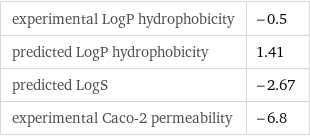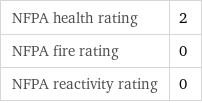Input interpretation

doxorubicin
Chemical names and formulas
![formula | C_27H_29NO_11 name | doxorubicin IUPAC name | (7S, 9R)-7-[(2S, 4S, 5S, 6S)-4-amino-5-hydroxy-6-methyl-oxan-2-yl]oxy-6, 9, 11-trihydroxy-9-(2-hydroxyacetyl)-4-methoxy-8, 10-dihydro-7H-tetracene-5, 12-dione alternate names | (85-cis)-10 | adriamycin | adriblastin | adriblastina mass fractions | C (carbon) 59.7% | H (hydrogen) 5.38% | N (nitrogen) 2.58% | O (oxygen) 32.4%](../image_source/a9280a7bedb44fc24d6f2df1a387551a.png)
formula | C_27H_29NO_11 name | doxorubicin IUPAC name | (7S, 9R)-7-[(2S, 4S, 5S, 6S)-4-amino-5-hydroxy-6-methyl-oxan-2-yl]oxy-6, 9, 11-trihydroxy-9-(2-hydroxyacetyl)-4-methoxy-8, 10-dihydro-7H-tetracene-5, 12-dione alternate names | (85-cis)-10 | adriamycin | adriblastin | adriblastina mass fractions | C (carbon) 59.7% | H (hydrogen) 5.38% | N (nitrogen) 2.58% | O (oxygen) 32.4%
Lewis structure

Draw the Lewis structure of doxorubicin. Start by drawing the overall structure of the molecule, ignoring potential double and triple bonds: Count the total valence electrons of the carbon (n_C, val = 4), hydrogen (n_H, val = 1), nitrogen (n_N, val = 5), and oxygen (n_O, val = 6) atoms: 27 n_C, val + 29 n_H, val + n_N, val + 11 n_O, val = 208 Calculate the number of electrons needed to completely fill the valence shells for carbon (n_C, full = 8), hydrogen (n_H, full = 2), nitrogen (n_N, full = 8), and oxygen (n_O, full = 8): 27 n_C, full + 29 n_H, full + n_N, full + 11 n_O, full = 370 Subtracting these two numbers shows that 370 - 208 = 162 bonding electrons are needed. Each bond has two electrons, so in addition to the 72 bonds already present in the diagram add 9 bonds. To minimize formal charge oxygen wants 2 bonds and carbon wants 4 bonds. Identify the atoms that want additional bonds and the number of electrons remaining on each atom: Fill in the 9 bonds by pairing electrons between adjacent highlighted atoms. Note that the six atom rings are aromatic, so that the single and double bonds may be rearranged: Answer: | |
3D structure

3D structure
Basic properties

molar mass | 543.52 g/mol phase | solid (at STP) melting point | 216 °C
Units

Hydrophobicity and permeability properties

experimental LogP hydrophobicity | -0.5 predicted LogP hydrophobicity | 1.41 predicted LogS | -2.67 experimental Caco-2 permeability | -6.8
Basic drug properties

approval status | approved | investigational | small molecule drug categories | antibiotic | antineoplastic antibiotic | antineoplastic agent dosage forms | intravenous: powder, for solution | intravenous: solution

brand names | ADM | adriablastin | adriamycin | adriamycin PFS | adriamycin RDF | adriamycin semiquinone | adriblastin | adriblastina | caelyx | DM2 | doxil | doxo | myocet | RDF rubex | resmycin | rubex
Chemical identifiers

CAS number | 23214-92-8 Beilstein number | 1445811 PubChem CID number | 31703 PubChem SID number | 173764 SMILES identifier | CC1C(C(CC(O1)OC2CC(CC3=C(C4=C(C(=C23)O)C(=O)C5=C(C4=O)C=CC=C5OC)O)(C(=O)CO)O)N)O InChI identifier | InChI=1/C27H29NO11/c1-10-22(31)13(28)6-17(38-10)39-15-8-27(36, 16(30)9-29)7-12-19(15)26(35)21-20(24(12)33)23(32)11-4-3-5-14(37-2)18(11)25(21)34/h3-5, 10, 13, 15, 17, 22, 29, 31, 33, 35-36H, 6-9, 28H2, 1-2H3/t10-, 13-, 15-, 17-, 22+, 27-/m0/s1 InChI key | AOJJSUZBOXZQNB-TZSSRYMLBG EU number | 245-495-6 RTECS number | AV9800000 NSC number | 123127
NFPA label

NFPA label

NFPA health rating | 2 NFPA fire rating | 0 NFPA reactivity rating | 0
Toxicity properties

RTECS classes | tumorigen | drug | mutagen | reproductive effector | human data | natural product | primary irritant